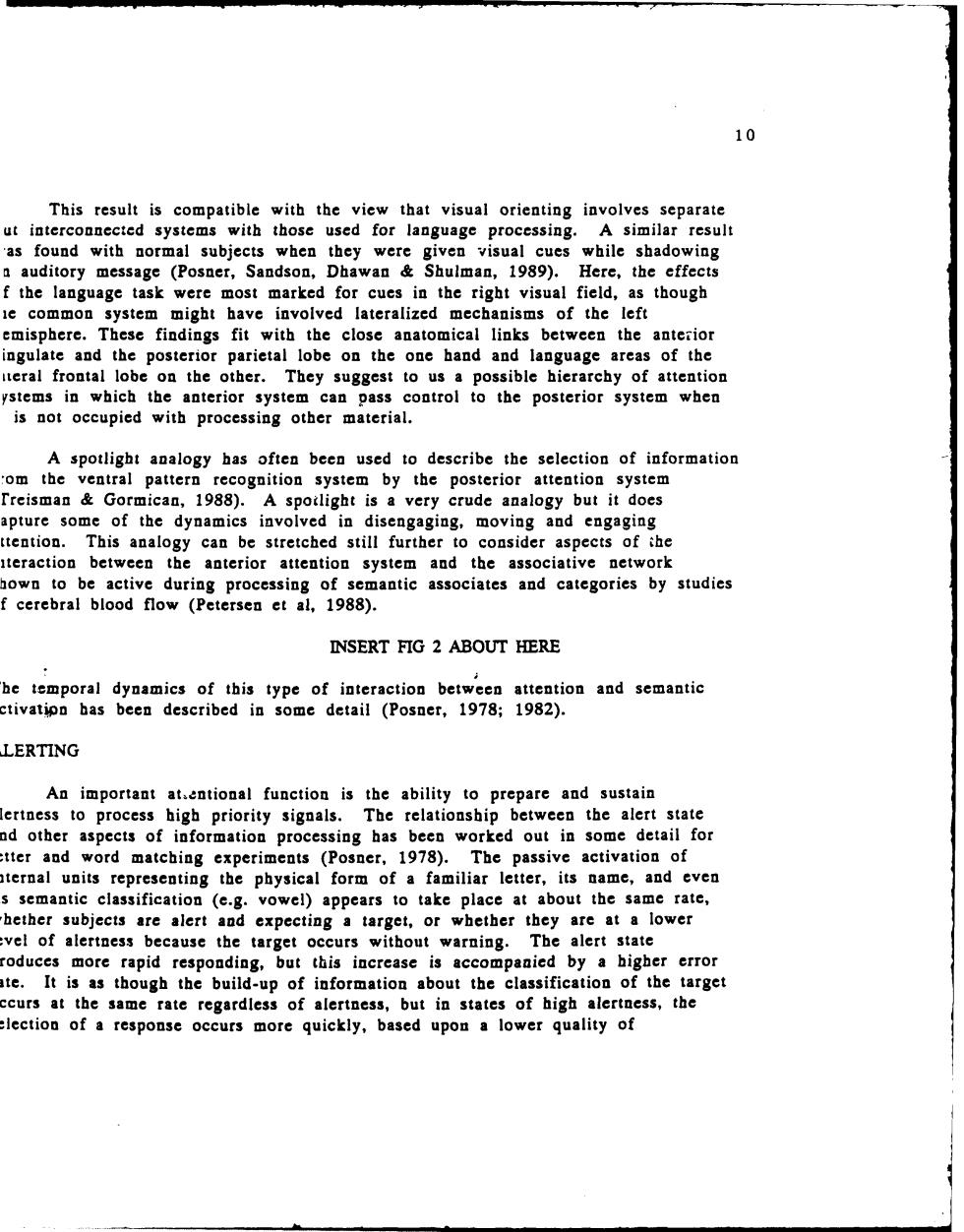正在加载图片...

10 This result is compatible with the view that visual orienting involves separate systems with those used for language processing. A similar result as ound subjects they were given visual cues while shadowing auditory me age (Posner,Sandson, Dhawan Shulman,1989). Here,the effects the language task were most marked for cues in the right visual field,as though common system might have involved lateralized mechanisms of the left These findings fit with the close anatomical links between the anterior ingulate the posterior parietal lobe on the one hand and language areas of the teral fro on the other. They suggest to us a possible hierarchy of attention the anterior system can pass control to the posterior system when i500 occupied with processing other material. spotligh analogy has often been use to describe the selection of information ognition pos attention system 19 very cru d :analogy but it does dynan ngaging, moving and engaging be stretched still further consider aspects of ihe teraction the anterior attention system and the ass ociative network be ac during processing of semantic associates and categories by studies cerebral blood (Petersen et al,1988). INSERT FIG 2 ABOUT HERE he temporal dynamics of this type of interaction between attention and semantic been described in some detail (Posner,1978;1982). LERTING An important at.entional function is the ability to prepare and sustain ertness to process high priority signals.The relationship between the alert state d other aspects of information processing has been worked out in some detail for tter and word matching experiments (Posner,1978).The passive activation of ternal units representing the physical form of a familiar letter,its name,and even semantic classification (e.g.vowel)appears to take place at about the same rate, hether subjects are alert and expecting a target,or whether they are at a lower vel of alertness because the target occurs without warning.The alert state oduces more rapid responding,but this increase is accompanied by a higher error te.It is as though the build-up of information about the classification of the target curs at the same rate regardless of alertness,but in states of high alertness,the lection of a response occurs more quickly,based upon a lower quality of10 This result is compatible with the view that visual orienting involves separate ut interconnected systems with those used for language processing. A similar result as found with normal subjects when they were given visual cues while shadowing a auditory message (Posner, Sandson, Dhawan & Shulman, 1989). Here, the effects f the language task were most marked for cues in the right visual field, as though ie common system might have involved lateralized mechanisms of the left emisphere. These findings fit with the close anatomical links between the anterior ingulate and the posterior parietal lobe on the one hand and language areas of the iferal frontal lobe on the other. They suggest to us a possible hierarchy of attention ystems in which the anterior system can pass control to the posterior system when is not occupied with processing other material. A spotlight analogy has often been used to describe the selection of information om the ventral pattern recognition system by the posterior attention system rreisman & Gormican, 1988). A spotlight is a very crude analogy but it does apture some of the dynamics involved in disengaging, moving and engaging ttention. This analogy can be stretched still further to consider aspects of ^he iteraction between the anterior attention system and the associative network hown to be active during processing of semantic associates and categories by studies f cerebral blood flow (Petersen et al, 1988). INSERT FIG 2 ABOUT HERE 'he temporal dynamics of this type of interaction between attention and semantic ctivatign has been described in some detail (Posner, 1978; 1982). LERTING An important atantional function is the ability to prepare and sustain lertness to process high priority signals. The relationship between the alert state nd other aspects of information processing has been worked out in some detail for -tter and word matching experiments (Posner, 1978). The passive activation of iternal units representing the physical form of a familiar letter, its name, and even s semantic classification (e.g. vowel) appears to take place at about the same rate, 'hether subjects are alert and expecting a target, or whether they are at a lower :vel of alertness because the target occurs without warning. The alert state roduces more rapid responding, but this increase is accompanied by a higher error ite. It is as though the build-up of information about the classification of the target ccurs at the same rate regardless of alertness, but in states of high alertness, the election of a response occurs more quickly, based upon a lower quality of